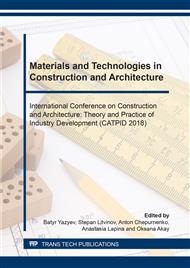[1]
G.I. Yakovlev, G.N. Pervushin, A. Korzhenko, A.F. Burianov, Ya. Kerene, I.S. Maeva, D.R. Khazeev, I.A. Pudov, S.A. Sen'kov, Application of dispersions of multilayered carbon nanotubes in the production of silicate gas concrete autoclaved hardening, Constructional Materials. 2 (2013).
Google Scholar
[2]
E.A. Karpova, E.M Ali., G. Skripkjunas, Ya. Keren, A. Kichaite, G.I. Yakovlev, M. Matsiauskas, I.A. Pudov, E.V. Aliev, S.A. Sen'kov, Modification of cement concrete with complex additives based on polycarboxylate esters, carbon nanotubes and microsilica, Constructional Materials. 2 (2015).
Google Scholar
[3]
S. Petrunin, V. Vaganov, K. Sobolev, Cement composites reinforced with functionalized carbon nanotubes, in: Advanced Structural Materials, Cambridge, 2014, pp.133-138.
DOI: 10.1557/opl.2014.769
Google Scholar
[4]
G. Yakovlev, G. Pervushin, I. Maeva, I. Pudov, A. Shaybadullina, J. Keriene, A. Buryanov, A. Korzhenko, S. Senkov, Modification of construction materials with multi-walled carbon nanotubes, in: Procedia Engineering Modern Building Materials, Structures and Techniques,, 2013, pp.407-413.
DOI: 10.1016/j.proeng.2013.04.053
Google Scholar
[5]
G.I. Yakovlev, G.N. Pervushin, Ya. Kerene, I.S. Polyanskih, I.A. Pudov, D.R. Khazeev, S.A. Senkov, Complex additive based on carbon nanotubes and microsilica for modifying of gas silicates of autoclave hardening, Constructional Materials. 1-2 (2014).
Google Scholar
[6]
S.Yu. Shekhovtsova, M.A. Vysotskaya, Influence of carbon nanotubes on the properties of polymer-bitumen binders and asphalt concrete, Vestnik MGSU. 11 (2015) 110-119.
DOI: 10.22227/1997-0935.2015.11.110-119
Google Scholar
[7]
S.V. Samchenko, O.V. Zemskova, I.V. Kozlova, Stabilization of Carbon Nanotubes with Superplasticizers Basedon Polycarboxylate Resin Ethers, Russian Journal of Applied Chemistry. 12 (2014) 1872 – 1876.
DOI: 10.1134/s1070427214120131
Google Scholar
[8]
S.V. Samchenko, O.V. Zemskova, I.V. Kozlova, Ultradisperse slag suspensions aggregative and sedimentative stability, MATEC Web of Conferences. 106 (2017) 03017.
DOI: 10.1051/matecconf/201710603017
Google Scholar
[9]
S.V. Samchenko, O.V. Zemskova, I.V. Kozlova, The efficiency of application of physical and chemical methods on the homogeneous dispersion of carbon nanotubes in water suspension, Cement-Wapno-Beton. 5 (2015) 322-327.
Google Scholar
[10]
E.V. Korolev, M.I. Kuvshinova, Ultrasonic parameters for the homogenization of disperse systems with nanosized modifiers, Constructional Materials. 9 (2010) 85 – 88.
Google Scholar
[11]
E.V. Korolev, A.S. Inozemtsev, Efficiency of physical effects for the dispersion of nanosized modifiers, Constructional Materials. 1 (2012) 1 – 4.
Google Scholar
[12]
V.I. Roldugin, About the unified mechanism of action of surface forces of various nature, Colloid Journal. 2 (2015) 214-219.
Google Scholar
[13]
A.A. Sobolev, Structural, rheological and electrical properties of suspensions of technical carbon of varying degrees of oxidation in polar and non-polar dielectric dispersion media, Colloid Journal. 3 (2015) 364-377.
DOI: 10.1134/s1061933x15030175
Google Scholar
[14]
E.A. Zakharychev, M.A. Kabina, E.N. Razov, L.L. Semenycheva, Investigation of the stability of aqueous suspensions of functionalized carbon nanotubes, Colloid Journal. 5 (2016) 556-561.
DOI: 10.1134/s1061933x16050240
Google Scholar
[15]
V.N. Tseluykin, Preparation of dispersions of fullerene C60 in water, Colloid Journal. 5 (2016) 668-670.
Google Scholar
[16]
E.V. Korolev, Estimation of the concentration of primary nanomaterials for the modification of building composites, Constructional Materials. 6 (2014) 31-34.
Google Scholar


